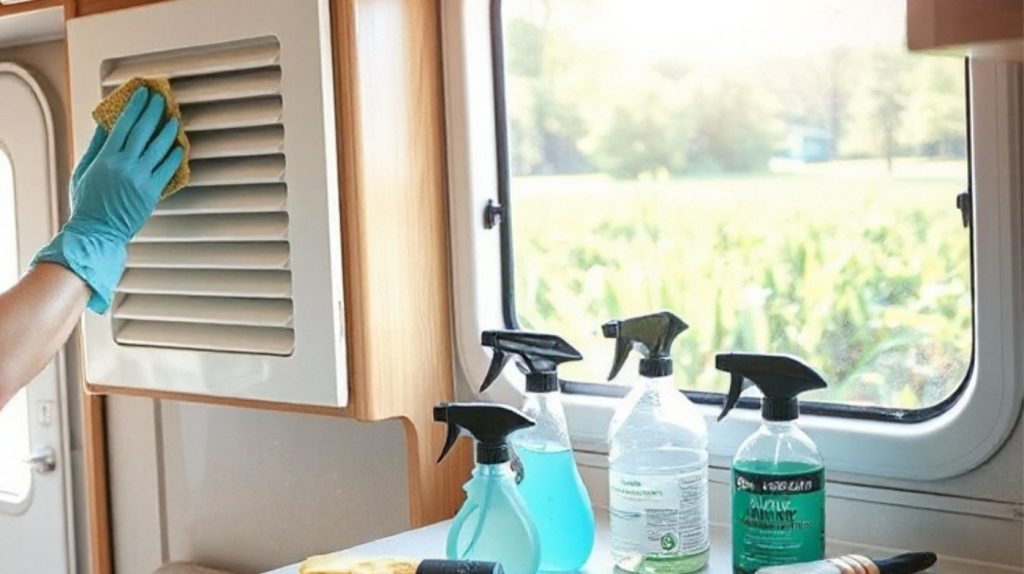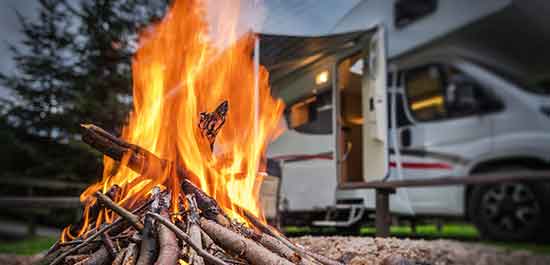Last Updated on June 24, 2025
To get rid of mold in your camper, first identify affected areas by looking for discolored spots and musty odors. Wear protective gear like gloves and a respirator, then seal leaks and reduce humidity below 60% with a dehumidifier.
Clean moldy surfaces using eco-friendly or bleach solutions, scrubbing thoroughly and drying completely. Proper ventilation and moisture control are key to preventing regrowth.
Explore effective cleaning methods and maintenance tips to keep your camper mold-free long term.
Key Takeaways
- Identify mold spots by looking for black, green, or white patches and musty odors in corners, under sinks, and near vents.
- Fix leaks promptly, maintain indoor humidity below 60%, and increase ventilation using fans or open windows.
- Wear gloves, goggles, and a respirator; use eco-friendly cleaners like vinegar or commercial mold removers on affected surfaces.
- Scrub mold with cleaning solutions, rinse thoroughly, dry completely, and dispose of water-damaged materials safely.
- Prevent regrowth by monitoring humidity, sealing leaks, using dehumidifiers, improving airflow, and regularly inspecting camper surfaces.
Identifying Mold in Your Camper
How can you quickly spot mold in your camper before it spreads? Look for black, green, white, or grayish spots on walls, ceilings, furniture, and fabrics. Mildew appears as flat, powdery patches, often white, yellow, or brown on organic materials.
Check for stains, bulges, peeling paint, or a filmy layer on windows and furniture—these indicate moisture and potential mold growth. Mold thrives in corners, under sinks, near vents, and around windows.
Use your nose: a musty or damp odor, especially near carpets or upholstery, signals mold presence. Regularly inspect hidden areas with a flashlight and magnifying glass, and monitor humidity levels above 60%, which favor mold growth.
Early detection involves checking for water stains, rust, and softened materials to catch mold before it penetrates surfaces. Maintaining proper water flow with heated RV hoses can help prevent moisture build-up and reduce mold risk in cold conditions.
Essential Safety Measures for Mold Removal
Before you begin mold removal in your camper, prioritize essential safety measures to protect yourself from health risks posed by mold spores and cleaning chemicals. Wear durable gloves, goggles, and a properly fitted respirator rated for mold spores.
Long-sleeved clothing and pants minimize skin exposure. Ensure all PPE is in good condition. Choosing cleaning products with environmental safety considerations helps reduce harmful impacts during mold removal.
Promote ventilation by opening windows and using fans or HEPA air purifiers to disperse airborne spores. Avoid HVAC use during cleaning or replace filters afterward.
When removing mold-contaminated materials, seal waste in plastic bags and avoid shaking to prevent spore spread. Cleaning mold promptly is important because mold can spread quickly if not addressed. Clean tools and protective gear post-use to prevent cross-contamination.
Finally, control moisture by repairing leaks and using dehumidifiers to maintain humidity below 60%, preventing mold recurrence and ensuring a safer environment during and after cleanup.
Effective Cleaning Solutions for Mold Treatment
When tackling mold in your camper, selecting the right cleaning solution is crucial for effective removal and prevention of regrowth. Your choice depends on surface type, mold severity, and environmental concerns.
Consider these options:
- Commercial Cleaners (e.g., MiracleMist): Fast-acting, safe for sensitive surfaces like EPDM roofs, no-rinse formulas reduce labor. Many users appreciate how these products save significant time by eliminating the need for scrubbing.
- Bleach Solutions (1:10 ratio): Highly effective on hard, non-porous surfaces; requires thorough rinsing and ventilation.
- Natural Cleaners (Vinegar, Tea Tree Oil): Eco-friendly, less abrasive, suitable for light to moderate mold; may need repeated application.
- Dish Soap Mixtures: Good for surface grime and mild mold; often combined with other agents for better efficacy.
Step-by-Step Mold Removal Process
Before starting mold removal, you need to thoroughly prepare by inspecting all affected areas. Ensure proper ventilation and wear protective gear. Remove any items from the space and address moisture sources to prevent mold from returning.
Since moisture is the primary factor promoting mold growth, controlling dampness is essential to effective remediation. Using eco-friendly cleaners can also reduce health risks during the cleaning process.
Once prepared, focus on cleaning mold with appropriate solutions and thoroughly drying surfaces to inhibit regrowth.
Preparation and Safety
Since mold thrives in damp environments, identifying and eliminating moisture sources is essential to effective preparation and safety in your camper’s mold removal process.
Inspect plumbing, roof seals, and windows for leaks, and assess ventilation inefficiencies that trap humidity. Use moisture meters or infrared cameras to detect hidden damp spots and promptly repair leaks.
Regular moisture checks are essential at the beginning and end of RV seasons to prevent mold buildup. Applying waterproof repair tape to vulnerable seams can help prevent moisture intrusion and reduce future mold risk.
Prioritize personal protective equipment (PPE) to safeguard yourself during removal. Implement ventilation controls to reduce airborne spores and humidity.
Prepare the cleaning area by removing contaminated items and protecting unaffected surfaces. Key preparation and safety steps include:
- Wear N95 masks, gloves, goggles, and protective clothing
- Increase airflow with open windows, fans, and dehumidifiers to help manage moisture and prevent mold formation
- Remove mold-infested porous materials and vacuum with a HEPA filter
- Securely seal and dispose of contaminated waste to prevent spore spread
Cleaning and Drying
Although mold removal involves several stages, starting with thorough cleaning and drying is essential to halt its spread and damage. Begin by applying a cleaning solution one part bleach to four parts water or equal parts vinegar and water—generously to affected areas.
Let it sit 15-20 minutes before scrubbing with a brush, focusing on corners and crevices. Rinse thoroughly and repeat if necessary. Using a biodegradable cleaner can help ensure safe and effective mold removal without damaging surfaces.
Remove any water-damaged materials like paneling or insulation to prevent regrowth, then safely dispose of them. During this process, wearing protective gear is important to avoid exposure to mold spores and contaminants.
Next, maximize ventilation by opening all windows, doors, and vents, and use fans to accelerate drying. Fully expose pop-up campers to sunlight. Ensure all surfaces, including hidden cavities, are completely dry use moisture meters if available before proceeding to prevent further mold development.
Preventing Mold Regrowth With Proper Maintenance
To prevent mold from returning, you need to maintain:
Consistent Humidity Control
How can you effectively prevent mold regrowth in your camper? Consistent humidity control is vital. Keep indoor relative humidity between 30% and 50%, never exceeding 60%, to inhibit mold spores. Use a reliable hygrometer or humidistat to monitor levels continuously.
Positioning the hygrometer at least five feet above the ground and away from direct sunlight ensures accurate readings of the humidity levels. Adjust ventilation and dehumidifier settings based on current conditions and camper size.
Additionally, selecting the right moisture control methods tailored to your camper’s materials can further enhance mold prevention. Key steps include:
- Employ RV-specific dehumidifiers with humidistats and adjustable airflow for precise moisture removal.
- Maintain good airflow via vent fans and open windows when possible, targeting moisture hotspots.
- Supplement with moisture absorbers like DampRid in enclosed or infrequently used spaces.
- Regularly dry wet surfaces and seal leaks to prevent external moisture intrusion.
Regular Inspection Routine
While regular humidity control forms the foundation for mold prevention in your camper, maintaining a strict inspection routine is essential to catch early signs of moisture problems before they escalate.
Before every trip, visually inspect bathrooms, kitchens, cabinets, closets, window sills, and plumbing for dampness or leaks. Examine roofs, ceilings, and seams for cracks. Mold often thrives in places with moisture, warmth, and organic material.
Annually, conduct thorough checks of seals, caulking, plumbing, HVAC systems, and structural integrity. Using a Battery Management System in your camper’s electrical setup can help avoid moisture-related electrical issues.
Routinely clean and apply mold inhibitors to moisture-prone surfaces, and promptly remove moldy fabrics. Monitor water leaks by checking fixtures and roof seals, repairing damage immediately.
Ensure proper air circulation by using vents, exhaust fans, and dehumidifiers during storage. Adhering to these precise inspection and maintenance steps will effectively prevent mold regrowth in your camper.
Long-Term Strategies to Keep Your Camper Mold-Free
Because mold thrives in damp, poorly ventilated environments, implementing long-term strategies focused on moisture control, ventilation, and regular maintenance is essential to keep your camper mold-free.
Start by controlling humidity with a dehumidifier during storage and use. Optimize airflow by keeping cabinet doors open and running exhaust fans in moisture-prone areas.
Additionally, regularly check and maintain roof seals and drainage systems to prevent leaks and moisture entry roof maintenance. Using a performance tuner for your camper’s Ford V10 engine can indirectly help by ensuring the engine runs efficiently, reducing excess moisture from exhaust.
Regularly inspect seals, plumbing, and storage areas for leaks or water damage and address issues promptly. When storing, use an enclosed unit or a breathable RV cover to minimize condensation.
Key strategies include:
- Running a dehumidifier and using moisture absorbers inside the camper
- Keeping vents, windows, and cabinet doors open to promote airflow
- Conducting biannual inspections for leaks, mold, and water stains
- Storing the camper under cover or in an enclosed space to reduce moisture exposure
Frequently Asked Questions
Can Mold in Campers Cause Health Issues for Pets?
Yes, mold in campers can cause serious health issues for your pets. When they inhale mold spores, they risk respiratory problems like coughing and difficulty breathing. Mold mycotoxins may lead to severe conditions such as pulmonary hemorrhage.
Your pets might also experience skin irritation, allergic reactions, or gastrointestinal distress if they ingest moldy materials. Monitoring their symptoms and maintaining a mold-free environment is vital to protect their health effectively.
Are Certain Camper Materials More Prone to Mold Growth?
When it comes to mold, you can’t judge a book by its cover materials matter a lot. Wood, drywall, and carpet in your camper are prime spots for mold because they absorb moisture and provide nutrients.
Meanwhile, fiberglass shells, Azdel composite panels, and treated laminates resist mold since they don’t hold water or organic matter. So, choosing mold-resistant materials and maintaining proper ventilation will keep mold growth at bay effectively.
How Long Can Mold Spores Survive in a Dry Camper?
Mold spores can survive for months to years in a dry camper by entering a dormant state. They don’t die without moisture but wait until conditions improve to grow. Factors like temperature stability, UV exposure, and material porosity influence their longevity.
To limit spore survival, you need to control moisture, repair leaks, and guarantee good airflow. Dry, clean environments reduce their viability markedly over extended periods.
Is Mold Removal Covered by Camper Insurance Policies?
Mold removal isn’t typically covered by standard camper insurance policies since mold usually results from maintenance issues like leaks or poor ventilation, which insurers exclude.
However, if mold stems directly from a sudden, accidental event covered by your policy such as storm damage you might get coverage.
To protect yourself, consider purchasing mold-specific endorsements or riders. Always review your policy carefully and keep up with maintenance to maintain eligibility for any mold-related claims.
Can Mold Affect the Resale Value of a Camper?
Yes, mold can substantially affect your camper’s resale value. Visible mold or odor signals neglect and potential structural damage, causing buyers to lower offers by 10-30%. Mold issues also prolong selling times and reduce market demand.
Even if your camper’s depreciation is standard, mold accelerates value loss. Proper remediation documentation can help, but overall, mold presence decreases buyer confidence and forces price reductions to cover cleanup costs.
Stay in a Mold-Free Camper With Long-Term Maintenance and Prevention Strategies
By tackling mold in your camper head-on, you’re cutting the roots before they spread like wildfire. Follow safety protocols and use proven cleaning solutions to strike at mold’s core.
Regular maintenance acts as your camper’s immune system, keeping spores at bay and ensuring a fresh, healthy environment. Stay vigilant and proactive, think of mold prevention as a shield, guarding your home on wheels from unseen invaders that thrive in damp shadows.



